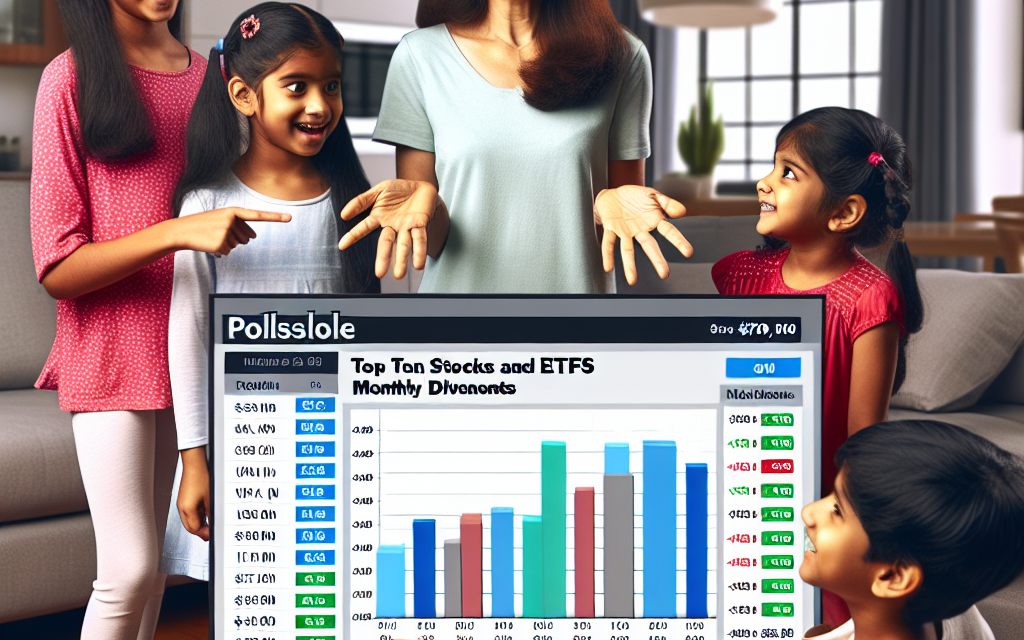“Unlocking Financial Freedom: A Mom’s Guide to a $3,700 Monthly Dividend Portfolio”
Introduction
In today’s volatile financial landscape, achieving a steady stream of passive income is a goal for many investors. For one mother of three, this aspiration has become a reality through her meticulously curated dividend portfolio, which generates an impressive $3,700 in monthly income. By strategically selecting a mix of top-performing stocks and exchange-traded funds (ETFs), she has crafted a robust investment strategy that balances growth and income. This article delves into her top 10 stock and ETF picks, offering insights into how she has built a resilient portfolio that not only supports her family’s financial needs but also provides a blueprint for others seeking to enhance their own investment strategies.
Understanding Dividend Portfolios: A Mother’s Journey
In the realm of personal finance, the journey toward financial independence often begins with a single step. For many, this step involves the strategic creation of a dividend portfolio, a collection of stocks and exchange-traded funds (ETFs) that generate regular income through dividends. One inspiring example of this approach is the story of a mother of three who has successfully built a $3,700 monthly dividend portfolio. Her journey offers valuable insights into the world of dividend investing and highlights the potential for financial security through careful planning and investment.
The foundation of her portfolio is built on a diversified selection of stocks and ETFs, each chosen for their ability to provide consistent and reliable dividend income. This mother of three has meticulously researched and selected ten key investments that form the backbone of her portfolio. These investments are not only designed to generate income but also to offer growth potential, ensuring that her portfolio remains robust in the face of market fluctuations.
Among her top ten holdings are several well-established companies known for their strong dividend histories. These include blue-chip stocks such as Johnson & Johnson and Procter & Gamble, both of which have a long track record of paying and increasing dividends. By including such stalwarts in her portfolio, she ensures a level of stability and predictability in her income stream, which is crucial for managing household expenses and planning for the future.
In addition to individual stocks, this mother has also incorporated ETFs into her portfolio. ETFs offer the advantage of diversification, allowing investors to spread risk across a broad range of assets. One of her preferred ETFs is the Vanguard Dividend Appreciation ETF, which focuses on companies with a history of increasing dividends. This choice reflects her strategy of prioritizing growth alongside income, as companies that consistently raise dividends often exhibit strong financial health and growth potential.
Transitioning from individual stocks to ETFs, her portfolio also includes the SPDR S&P Dividend ETF, which tracks the performance of high-yielding dividend stocks. This ETF provides exposure to a wide array of sectors, further enhancing the diversification of her portfolio. By balancing individual stock investments with ETFs, she effectively mitigates risk while maximizing her potential for income generation.
Moreover, her approach to dividend investing is not solely focused on immediate returns. She emphasizes the importance of reinvesting dividends to compound growth over time. By reinvesting dividends, she allows her portfolio to grow organically, increasing her future income potential and building a more substantial financial cushion for her family.
Her journey underscores the importance of patience and discipline in dividend investing. Building a portfolio that generates $3,700 in monthly income did not happen overnight. It required careful planning, consistent contributions, and a long-term perspective. Her story serves as a testament to the power of dividend investing as a means of achieving financial independence and security.
In conclusion, the experience of this mother of three illustrates the potential of dividend portfolios to provide a steady income stream while also offering growth opportunities. Her strategic selection of stocks and ETFs, combined with a disciplined approach to reinvesting dividends, has enabled her to create a robust portfolio that supports her family’s financial needs. Her journey offers valuable lessons for anyone seeking to embark on a similar path toward financial independence through dividend investing.
Top 10 Stocks and ETFs for Reliable Monthly Income
In the realm of personal finance, generating a reliable monthly income through investments is a goal many aspire to achieve. For one mother of three, this aspiration has become a reality through a carefully curated dividend portfolio that yields $3,700 each month. Her strategy, which focuses on a blend of stocks and exchange-traded funds (ETFs), offers valuable insights for those seeking to build a similar income stream. By examining her top ten holdings, we can gain a deeper understanding of how to construct a portfolio that balances risk and reward while providing consistent returns.
To begin with, the foundation of her portfolio is built on a selection of blue-chip stocks known for their stability and history of dividend payments. Among these, Johnson & Johnson stands out as a cornerstone investment. With its diversified product lines and strong financial health, Johnson & Johnson has consistently delivered dividends, making it a reliable choice for income-focused investors. Similarly, Procter & Gamble, another stalwart in the consumer goods sector, offers a robust dividend yield, supported by its extensive portfolio of trusted brands.
Transitioning to the financial sector, the inclusion of JPMorgan Chase highlights the importance of banking stocks in a dividend portfolio. As one of the largest financial institutions in the world, JPMorgan Chase not only provides a steady dividend but also benefits from a diversified revenue stream, which helps mitigate risks associated with economic fluctuations. In the same vein, Realty Income Corporation, often referred to as “The Monthly Dividend Company,” is a real estate investment trust (REIT) that specializes in generating monthly income for its investors. Its focus on high-quality commercial properties and long-term leases ensures a dependable cash flow.
Moreover, the portfolio incorporates technology stocks, which, while traditionally known for growth rather than income, have increasingly become attractive for dividend investors. Microsoft, with its strong balance sheet and commitment to returning capital to shareholders, exemplifies this trend. Its consistent dividend growth, coupled with its leadership in cloud computing and software, makes it a compelling choice for those seeking both income and potential appreciation.
In addition to individual stocks, the portfolio is diversified through ETFs, which offer exposure to a broad range of assets and sectors. The Vanguard High Dividend Yield ETF is a prime example, providing access to a basket of high-yielding stocks across various industries. This diversification helps reduce risk while maintaining a focus on income generation. Similarly, the iShares Select Dividend ETF targets companies with a strong track record of dividend payments, further enhancing the portfolio’s income potential.
Furthermore, the inclusion of the Schwab U.S. Dividend Equity ETF underscores the importance of cost-effective investing. With its low expense ratio and focus on high-quality U.S. companies, this ETF offers an efficient way to capture dividend income without incurring significant fees. Lastly, the SPDR S&P Dividend ETF rounds out the portfolio, offering exposure to companies with a history of increasing dividends over time, thereby providing a hedge against inflation.
In conclusion, this mother of three has successfully crafted a dividend portfolio that not only meets her financial needs but also serves as a model for others seeking reliable monthly income. By strategically selecting a mix of individual stocks and ETFs, she has achieved a balance between stability and growth, ensuring that her investments continue to generate returns in a variety of market conditions. As investors look to emulate her success, these top ten holdings offer a valuable blueprint for building a sustainable income-generating portfolio.
Building a $3,700 Monthly Dividend Portfolio: Key Strategies
Building a $3,700 monthly dividend portfolio is a goal that many investors aspire to achieve, and for one mother of three, it has become a reality. Her journey to creating a reliable income stream through dividends is a testament to strategic planning and disciplined investing. By carefully selecting a mix of stocks and exchange-traded funds (ETFs), she has managed to construct a portfolio that not only meets her financial needs but also provides a sense of security for her family’s future. Understanding the key strategies she employed can offer valuable insights for those looking to build their own dividend portfolios.
To begin with, diversification played a crucial role in her investment strategy. By spreading her investments across various sectors and industries, she minimized the risk associated with market volatility. This approach ensured that her portfolio was not overly reliant on any single company or sector, thereby providing a more stable income stream. For instance, she included stocks from the technology, healthcare, consumer goods, and financial sectors, each offering unique growth prospects and dividend yields. This diversification was further enhanced by incorporating ETFs, which inherently provide exposure to a broad range of companies within a single investment.
In addition to diversification, the selection of high-quality dividend-paying stocks was paramount. The mother of three focused on companies with a strong track record of paying and increasing dividends over time. These companies typically have robust financial health, stable cash flows, and a commitment to returning capital to shareholders. By prioritizing such stocks, she ensured that her portfolio would generate consistent and growing income. Furthermore, she paid close attention to the dividend yield and payout ratio, seeking a balance between attractive yields and sustainable payout levels.
Another key strategy was the reinvestment of dividends. By reinvesting the dividends received, she was able to take advantage of the power of compounding. This approach not only increased her shareholdings over time but also enhanced her portfolio’s income-generating potential. Reinvesting dividends allowed her to purchase additional shares without having to inject new capital, thereby accelerating the growth of her portfolio.
Moreover, she maintained a long-term perspective, understanding that building a substantial dividend portfolio requires patience and persistence. Market fluctuations and economic cycles are inevitable, but by staying focused on her long-term goals, she was able to weather short-term volatility. This mindset also helped her avoid the temptation to chase high yields from riskier investments, which could jeopardize the stability of her income stream.
Finally, regular portfolio review and rebalancing were integral to her strategy. By periodically assessing her portfolio’s performance and making necessary adjustments, she ensured that her investments remained aligned with her financial objectives. This proactive approach allowed her to capitalize on new opportunities and mitigate potential risks, thereby maintaining the integrity of her dividend portfolio.
In conclusion, building a $3,700 monthly dividend portfolio requires a combination of diversification, careful stock selection, dividend reinvestment, a long-term perspective, and regular portfolio management. By employing these strategies, the mother of three successfully created a reliable income stream that supports her family’s financial well-being. Her experience serves as an inspiring example for investors seeking to achieve similar goals, demonstrating that with dedication and strategic planning, a substantial dividend portfolio is within reach.
Balancing Risk and Reward in Dividend Investing

In the realm of personal finance, dividend investing has emerged as a popular strategy for those seeking a steady stream of income. Recently, a mother of three has garnered attention by revealing her $3,700 monthly dividend portfolio, which is composed of a carefully curated selection of stocks and ETFs. This portfolio not only highlights the potential of dividend investing but also underscores the importance of balancing risk and reward. As we delve into the specifics of her investment choices, it becomes evident that a strategic approach is essential for achieving financial stability and growth.
To begin with, the foundation of her portfolio is built on a mix of high-yield stocks and reliable ETFs, which together provide a diversified income stream. Among her top ten holdings, several well-established companies stand out, each offering a unique blend of stability and growth potential. For instance, she has invested in Johnson & Johnson, a stalwart in the healthcare sector known for its consistent dividend payouts. This choice reflects her preference for companies with a strong track record and a commitment to returning value to shareholders.
In addition to individual stocks, the inclusion of ETFs in her portfolio serves to mitigate risk while enhancing diversification. One notable ETF in her collection is the Vanguard Dividend Appreciation ETF, which focuses on companies with a history of increasing dividends over time. This ETF not only provides exposure to a broad range of industries but also aligns with her long-term investment goals by prioritizing dividend growth.
Moreover, her portfolio features a mix of domestic and international stocks, which further diversifies her income sources. By investing in companies like Procter & Gamble and Nestlé, she taps into the global consumer goods market, thereby reducing her reliance on any single economy. This international exposure is crucial in balancing risk, as it allows her to benefit from growth opportunities in various regions while cushioning against potential downturns in any one market.
Transitioning to the financial sector, she has allocated a portion of her portfolio to banks and financial institutions, such as JPMorgan Chase and Bank of America. These companies are known for their robust dividend policies and play a vital role in her strategy to generate consistent income. The financial sector’s cyclical nature does introduce some risk; however, her diversified approach helps to offset potential volatility.
Furthermore, the energy sector is represented in her portfolio through investments in companies like ExxonMobil. While the energy market can be unpredictable, the inclusion of such stocks is a testament to her willingness to embrace calculated risks for the prospect of higher returns. By balancing these riskier investments with more stable options, she effectively manages her portfolio’s overall risk profile.
In conclusion, the mother of three’s $3,700 monthly dividend portfolio exemplifies the delicate balance between risk and reward in dividend investing. Through a combination of high-yield stocks, reliable ETFs, and strategic diversification across sectors and geographies, she has crafted a portfolio that not only meets her income needs but also positions her for future growth. Her approach serves as a valuable lesson for investors seeking to navigate the complexities of dividend investing, emphasizing the importance of careful selection and diversification in achieving financial success.
How a Mother of Three Manages Her Investment Portfolio
In the realm of personal finance, managing an investment portfolio can often seem daunting, especially for those juggling multiple responsibilities. However, one mother of three has successfully navigated this complex landscape, revealing her $3,700 monthly dividend portfolio. Her approach offers valuable insights into how individuals can effectively manage their investments while balancing family life. By strategically selecting a mix of stocks and exchange-traded funds (ETFs), she has crafted a portfolio that not only provides a steady income stream but also aligns with her long-term financial goals.
To begin with, her investment strategy is rooted in diversification, a fundamental principle that mitigates risk by spreading investments across various sectors and asset classes. This mother of three has carefully chosen a blend of ten stocks and ETFs that collectively contribute to her monthly dividends. Among her top picks are well-established companies known for their consistent dividend payouts. These include stalwarts like Johnson & Johnson and Procter & Gamble, both of which have a long history of rewarding shareholders with regular dividends. By investing in such reliable companies, she ensures a stable foundation for her portfolio.
In addition to individual stocks, she has also incorporated ETFs to further enhance diversification. ETFs offer the advantage of providing exposure to a broad range of assets within a single investment, thereby reducing the impact of volatility in any one sector. For instance, she has invested in the Vanguard Dividend Appreciation ETF, which focuses on companies with a strong track record of increasing dividends over time. This choice reflects her commitment to growth-oriented investments that promise not only current income but also potential for future appreciation.
Moreover, her portfolio includes the SPDR S&P 500 ETF, a popular choice among investors seeking to mirror the performance of the broader market. By including this ETF, she taps into the collective strength of the largest U.S. companies, thereby benefiting from the overall economic growth. This strategic inclusion underscores her balanced approach, combining both individual stock selections and broad market exposure to optimize returns.
Transitioning to the management aspect, this mother of three emphasizes the importance of regular portfolio reviews. She dedicates time each month to assess the performance of her investments, ensuring they remain aligned with her financial objectives. This proactive approach allows her to make informed decisions, such as rebalancing her portfolio or reinvesting dividends to capitalize on compounding growth. Her disciplined routine exemplifies how consistent monitoring can lead to sustained financial success.
Furthermore, she highlights the significance of staying informed about market trends and economic developments. By keeping abreast of relevant news and analysis, she is better equipped to anticipate changes that may impact her investments. This knowledge empowers her to make timely adjustments, thereby safeguarding her portfolio against potential downturns.
In conclusion, the experience of this mother of three serves as an inspiring example for individuals seeking to manage their investment portfolios effectively. Through a combination of diversification, strategic selection of stocks and ETFs, and diligent portfolio management, she has achieved a reliable source of monthly income. Her story illustrates that with careful planning and a commitment to ongoing education, it is possible to successfully navigate the complexities of investing while balancing the demands of family life.
The Role of ETFs in a Dividend-Focused Strategy
In the realm of personal finance, dividend investing has emerged as a popular strategy for those seeking a steady stream of income. This approach involves investing in stocks and exchange-traded funds (ETFs) that regularly distribute a portion of their earnings to shareholders. For a mother of three who has successfully built a $3,700 monthly dividend portfolio, the role of ETFs cannot be overstated. These financial instruments offer a diversified, cost-effective, and relatively low-risk way to achieve consistent returns, making them an integral component of her investment strategy.
ETFs, by their very nature, provide investors with exposure to a broad range of assets, which can include stocks, bonds, or other securities. This diversification is particularly beneficial in a dividend-focused strategy, as it mitigates the risk associated with investing in individual stocks. By spreading investments across various sectors and industries, ETFs help cushion the portfolio against market volatility and economic downturns. For the mother of three, this means that her portfolio is not overly reliant on the performance of a single company or sector, thereby ensuring a more stable income stream.
Moreover, ETFs often come with lower expense ratios compared to mutual funds, making them a cost-effective choice for dividend investors. The reduced fees mean that a larger portion of the dividends can be reinvested or used to meet financial goals, such as funding her children’s education or contributing to retirement savings. This cost efficiency is crucial for maintaining the sustainability of her $3,700 monthly income, as it allows her to maximize returns without incurring significant costs.
In addition to diversification and cost efficiency, ETFs offer the advantage of liquidity. They are traded on major stock exchanges, much like individual stocks, which means they can be bought and sold throughout the trading day at market prices. This liquidity provides the mother of three with the flexibility to adjust her portfolio as needed, whether to capitalize on new opportunities or to rebalance her holdings in response to changing market conditions. Such flexibility is essential for maintaining a dynamic and responsive investment strategy that can adapt to her evolving financial needs.
Furthermore, the inclusion of ETFs in her portfolio allows for strategic exposure to high-dividend sectors and international markets. Many ETFs are designed to track indices that focus on dividend-paying companies, providing targeted access to firms with a history of reliable payouts. This targeted approach enables her to tap into global opportunities, thereby enhancing the potential for income generation. By investing in ETFs that focus on high-dividend sectors, she can benefit from the growth and stability of established companies while also exploring emerging markets that offer attractive yields.
In conclusion, the role of ETFs in a dividend-focused strategy is multifaceted and indispensable. For the mother of three, these financial instruments provide a balanced approach to income generation, combining diversification, cost efficiency, liquidity, and strategic market exposure. By leveraging the unique advantages of ETFs, she has successfully built a robust portfolio that delivers a consistent $3,700 monthly income, demonstrating the effectiveness of this investment strategy in achieving financial stability and growth. As more investors recognize the potential of dividend investing, the prominence of ETFs in such strategies is likely to continue to grow, offering a reliable path to financial independence.
Lessons Learned from a Successful Dividend Investor
In the realm of personal finance, the journey toward financial independence often involves strategic planning and disciplined investing. One inspiring example is a mother of three who has successfully built a dividend portfolio generating $3,700 in monthly income. Her story offers valuable insights into the world of dividend investing, highlighting the importance of patience, diversification, and informed decision-making. By examining her top 10 stocks and ETFs, we can glean lessons that are applicable to both novice and seasoned investors alike.
To begin with, the foundation of her portfolio is built on a diversified selection of dividend-paying stocks and ETFs. This diversification is crucial as it mitigates risk and ensures a steady income stream, even in volatile market conditions. Among her top holdings are well-established companies known for their reliable dividend payouts. For instance, she has invested in blue-chip stocks such as Johnson & Johnson and Procter & Gamble. These companies have a long history of not only paying dividends but also increasing them over time, which is a testament to their financial stability and commitment to returning value to shareholders.
In addition to individual stocks, this savvy investor has allocated a portion of her portfolio to dividend-focused ETFs. These funds offer exposure to a broad range of dividend-paying companies, providing instant diversification. Notable among her ETF holdings are the Vanguard Dividend Appreciation ETF and the iShares Select Dividend ETF. These ETFs are designed to track indices that focus on companies with a strong track record of dividend growth, thereby aligning with her investment strategy of prioritizing long-term income generation.
Moreover, her approach underscores the significance of conducting thorough research before making investment decisions. She emphasizes the importance of understanding a company’s financial health, payout ratio, and dividend yield. By doing so, she ensures that her investments are sustainable and capable of weathering economic downturns. This meticulous research process is a critical lesson for any investor aiming to build a robust dividend portfolio.
Furthermore, her experience highlights the power of reinvesting dividends. By reinvesting the dividends she receives, she takes advantage of compounding, which accelerates the growth of her portfolio over time. This strategy not only increases her future dividend income but also enhances the overall value of her investments. It is a testament to the adage that time in the market is more valuable than timing the market.
Another key takeaway from her journey is the importance of setting clear financial goals. Her objective of generating a specific amount of monthly income has guided her investment choices and kept her focused on her long-term vision. This clarity of purpose is essential for any investor, as it provides direction and motivation, especially during periods of market uncertainty.
In conclusion, the story of this mother of three serves as an inspiring example of how disciplined dividend investing can lead to financial independence. Her $3,700 monthly dividend portfolio, composed of top stocks and ETFs, is a testament to the effectiveness of diversification, thorough research, and strategic reinvestment. By learning from her experience, investors can adopt similar strategies to achieve their financial goals, ensuring a stable and growing income stream for the future.
Q&A
1. **What is the focus of the article?**
The article focuses on a mother of three who reveals her investment strategy, specifically her $3,700 monthly dividend portfolio.
2. **How much does the portfolio generate monthly?**
The portfolio generates $3,700 in dividends each month.
3. **What type of investments are included in the portfolio?**
The portfolio includes a mix of stocks and ETFs (Exchange-Traded Funds).
4. **How many stocks and ETFs are highlighted in the portfolio?**
The portfolio highlights a total of 10 stocks and ETFs.
5. **What is the primary goal of the portfolio?**
The primary goal of the portfolio is to generate consistent monthly income through dividends.
6. **Is the portfolio focused on growth or income?**
The portfolio is focused on income, specifically through dividends.
7. **What is the significance of the portfolio for the mother of three?**
The portfolio provides financial stability and additional income to support her family.
Conclusion
The article “Mother of Three Reveals Her $3,700 Monthly Dividend Portfolio: Top 10 Stocks and ETFs” highlights a strategic approach to building a dividend-focused investment portfolio that generates consistent monthly income. By carefully selecting a mix of high-yield stocks and ETFs, the individual has successfully created a diversified portfolio that balances risk and return. The emphasis on reliable dividend payers suggests a focus on financial stability and long-term growth, providing a practical example for investors seeking to achieve similar income-generating goals. This case underscores the importance of research, diversification, and strategic planning in constructing a portfolio that aligns with personal financial objectives.





